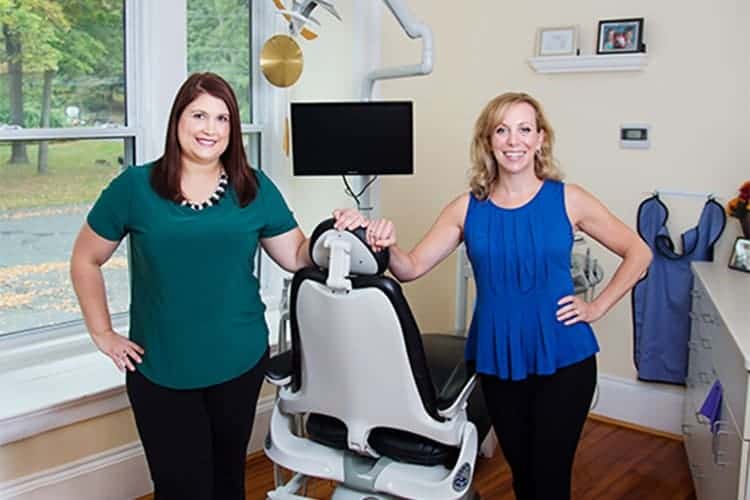This Farmington, CT Dentist Asks: Do You Have A Reluctant Brusher?


Good Oral Habits Start At Home!
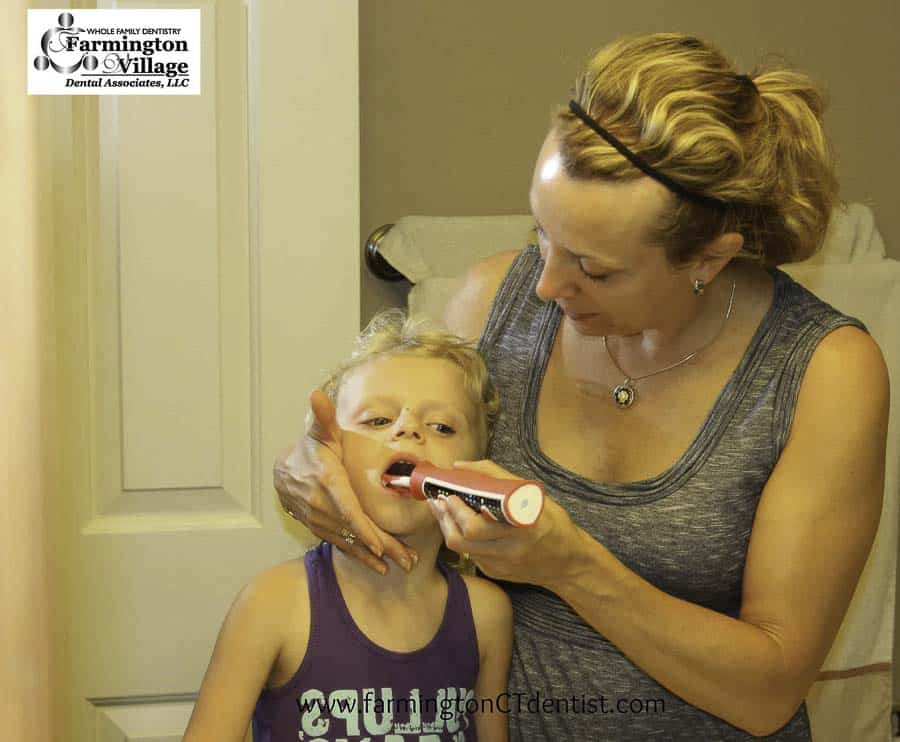
Do you have a child who doesn’t want to brush their teeth? Does your child fight you at toothbrushing time? If you do, you are not alone. Parents and caregivers often face the challenge of a child who resists brushing their teeth.
Let’s face it, kids don’t always jump on board with behaviors that we know are best for their future selves. That’s why it is our job as parents to make sure they make the proper choice. Sure, every kid wants to eat the cookie, but not every kid wants to eat their vegetables!
When it comes to toothbrushing, it’s imperative to get a child to cooperate for it. I promise you that I know what it’s like to encounter a child who does not want to brush their teeth. My children are now nine years old and I am happy to report that both of my kids are now brushing their teeth without any arguments, push back or drama. Not that long ago, however, there was often kicking, screaming, and lots of wiggling around. I even wrote a blog about it a few years ago. You can read it here.
For the youngest of children (birth to approximately six months old, basically up until the time the first tooth comes in), take a warm, wet washcloth and gently swipe your child’s gums. Yes, I know the child does not have teeth yet and I am not crazy here. Cleaning your child’s mouth long before they have teeth allows the child to become used to the experience of having something put into their mouth! Wiping their gums when they don’t have teeth should make them more accepting of a toothbrush when that first tooth comes in. The washcloth allows oral hygiene to become just another routine … like washing hands before eating.
Once the first tooth arrives (at about six months or a bit later), it’s time to get serious. This is also around the time that children are traditionally introduced to solid food, so it’s extremely important to get the food off of those sparkling new teeth, because those teeth can now get cavities! Because infants are not yet mobile, laying them down on the changing table is often the best way to get those new teeth brushed effectively.
Now that your child has their first tooth, it’s time to choose their first toothbrush.Here's a great toothbrush we recommend for toddlers. Please see this blog post (which happens to be about your child’s first dental appointment) if you’d like to see this toothbrush in action.
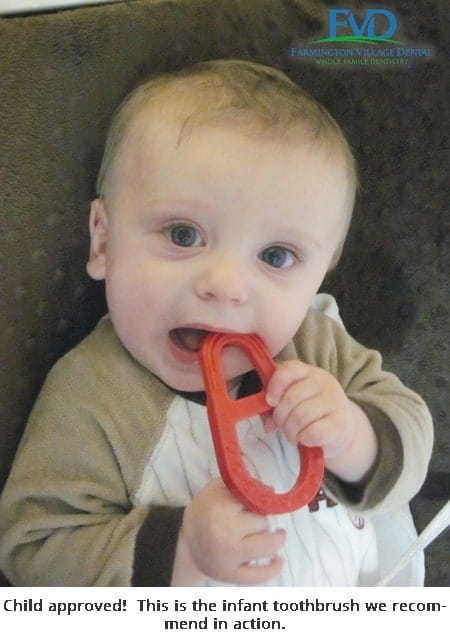
The brush is easily held in both an adult and a child’s hand, and the shape of the brush is great because the ovoid design prohibits kids from pushing the toothbrush too far back into their mouth. My advice at this stage is that the adult should brush the child’s teeth first and then let the child play around with the toothbrush and do it themselves. Don’t worry if they’re not doing it properly at this age and don’t worry if they start to chew on the handle. What’s nice about this brush is that in addition to the bristle end, there are little bumps on the handle so the child can chew around on it and make their gums feel better while they’re teething. While we’re on the subject of chewing around on the brush, here’s something to note about biting bristles: As your child gets older, this is a habit that should be discouraged. Of course, in the beginning, you want the child to hold and explore the toothbrush. In general, however, chewing on the bristles of any toothbrush is never recommended because the bristles can come loose and be ingested. Plus, chewing on the bristles doesn’t do much in the way of cleaning the teeth. Try to always encourage your child to “open wide” for proper brushing.
Once your child is walking, the real fights can begin. Once those little guys are mobile, they’re surprisingly fast, and they can be surprisingly strong! Here’s what I believe: You know this is something that needs to be done. You are the parent. You’re in charge! Please don’t give up if your child resists. Why not try to make the activity something fun? You could try group brushing as a family. Sometimes, when the reluctant brusher sees Mom, Dad, and/or another sibling – or anyone – brushing, they will want to brush too. Encouraging your child to model your behavior is often enough to get them to stop the fight.
If group brushing isn’t enough to get your child to brush, then it’s time to bring in a bigger effort on your part to get this done. Toothbrushing may be a two-person job for a while. You do this by one person gently holding the child’s head while the other brushes. You could even do this two-person job lying down – they’re movements are better controlled this way.
You might be wondering how to do this if you’re having to brush your child’s teeth on your own. I will tell you how I did this with my feisty little girl when my husband was out of the house.
I would lay her down on the floor and sit behind her. I’d put her head between my thighs to keep it still, and I would put my legs over her arms so she couldn’t hit me. She was one determined kid, but I was just as determined!
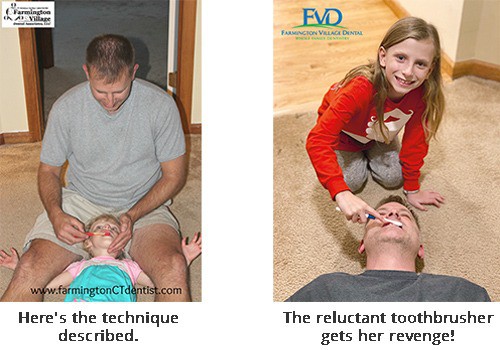
Of course, she hated it at first and she fought the process, but guess what? A screaming child has their mouth open, and it’s easy to get those teeth clean with their mouth wide open!
I realize this technique may not be for everyone but for us it was effective, and I can tell you that this phase didn’t last long. In a short matter of time, my daughter went from being out of control at toothbrushing time to being no problem at all.
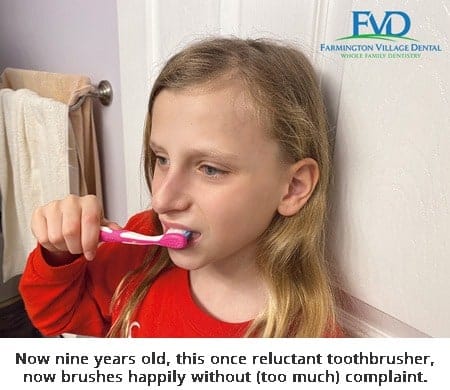
If you’re struggling to get your child to brush their teeth, give us a call. We are happy to discuss this more with you. We are always accepting new patients and we see children as young as one so that we can keep an eye on their development, ensure early cavity prevention, and help you with homecare routines.
The routines you start now, while your kids are young, will help set them up for a lifetime of success with a healthy, confident smile.
Yours in continuing dental health,
Dr. Monique Nadeau, your Family Dentist in Farmington, CT

